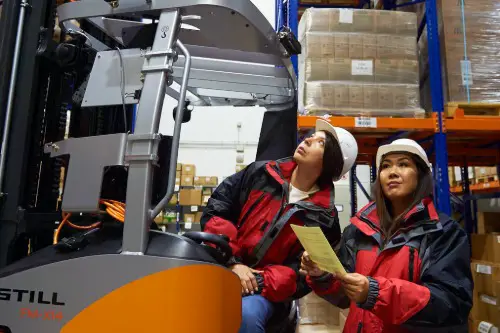1. Packaging And Shipping

The rise of e-commerce has fueled demand for warehouse efficiency, and AI is stepping up to fill the gap, Forbes reports. Robots powered by AI, like those developed by Amazon and Boston Dynamics, are already handling tasks such as sorting, packing, and inventory management in warehouses. These robots can navigate complex layouts, identify specific items, and transport goods faster than any human worker.
AI systems are particularly valuable in warehouses because of their ability to operate continuously without breaks. During peak seasons, such as the holidays, companies can scale up operations without the need to hire additional staff or worry about burnout. Although humans are still essential for managing exceptions and overseeing operations, the trend is clear: as AI becomes more capable, the demand for human warehouse workers will decline. For those in this field, transitioning to roles like robotics maintenance or logistics planning could be crucial to staying relevant in the workforce.
2. Customer Service

Customer service roles are increasingly being automated through AI chatbots and voice assistants. Platforms like Zendesk and Intercom are leveraging AI to handle customer queries, troubleshoot problems, and provide support—all in real time. These systems can manage multiple conversations simultaneously, reduce wait times, and provide 24/7 service, which is a huge advantage for businesses looking to improve customer satisfaction, according to Forbes.
AI-driven customer service isn’t just about efficiency—it’s also about personalization. Machine learning allows these bots to analyze previous interactions, anticipate customer needs, and provide tailored solutions. While humans are still needed for more complex issues, the growing capabilities of AI mean that many customer service roles will become redundant. By 2030, it’s likely that human representatives will primarily handle escalations, leaving most routine inquiries to AI.
3. Data Entry

If you’ve ever worked in a job that involves entering information into spreadsheets or databases, you’ve likely noticed how repetitive the tasks can be. That’s one of the main reasons AI is set to take over data entry roles, according to DK Business Consulting. With advancements in Optical Character Recognition (OCR) and Natural Language Processing (NLP), AI systems can now extract information from documents, invoices, and even handwritten notes with remarkable accuracy. These tools can process massive amounts of data in a fraction of the time it would take a human and without the risk of fatigue-based errors.
For companies, the appeal of AI in this area is undeniable: it’s faster, cheaper, and more reliable. Platforms like UiPath and Automation Anywhere already allow businesses to automate repetitive data entry tasks, and their adoption is only growing. While humans may still be needed for supervising these systems or handling unusual cases, the sheer efficiency of AI means fewer data entry jobs will exist by the end of the decade. This shift highlights the importance of upskilling for workers in this field, as automation will likely dominate these tasks in the years ahead.
4. Telemarketing

Telemarketing is another profession that’s rapidly being automated, and it’s easy to see why. AI-powered bots are already handling cold calls, customer surveys, and appointment scheduling. These systems, often powered by advanced conversational AI tools like ChatGPT, are designed to sound natural and engage with customers just like a human would, according to The Economist. They can work around the clock, make hundreds of calls simultaneously, and follow up without missing a beat—all without requiring a paycheck or time off.
For businesses, this shift means substantial cost savings. AI doesn’t just replace human telemarketers; it also improves efficiency by using data analytics to target the right audience. These bots can be trained to adjust their tone and responses based on the person they’re speaking to, making them surprisingly effective at sales and lead generation. The rise of AI in telemarketing reflects a broader trend toward automating customer-facing roles. As AI improves, it’s not hard to imagine a future where you rarely hear from a human telemarketer again.
5. Banking

The banking industry has been adopting automation for years, and AI is taking it to the next level. Many routine banking tasks, such as deposits, withdrawals, and account inquiries, can now be handled through ATMs or mobile apps. AI-powered systems are also being used to provide financial advice, detect fraud, and even approve loans.
One reason bank teller jobs are particularly vulnerable is the shift toward digital banking. Customers increasingly prefer the convenience of managing their finances online, and AI tools make it easy for banks to meet this demand. For example, chatbots like Erica from Bank of America can assist customers with account management and budgeting, reducing the need for in-person interactions. While some roles will remain for those who prefer face-to-face service, the overall trend points to fewer opportunities for traditional bank tellers.
6. Retail

AI is already changing the retail landscape, and cashiers are among the most affected, J Recruiting Services explains. Self-checkout kiosks have become a common sight in grocery stores and supermarkets, allowing customers to scan and pay for their items without human assistance. More advanced systems, like Amazon’s “Just Walk Out” technology, go a step further by using sensors and cameras to automatically charge customers as they leave the store, eliminating the need for a checkout process altogether.
The appeal of automation in retail is clear: it reduces labor costs, speeds up transactions, and enhances customer convenience. While cashiers may still be needed to handle complex transactions or assist with issues, their role is shrinking as automation becomes the norm. For retail workers, this shift underscores the importance of developing skills in areas like inventory management or customer engagement to stay competitive.
7. Medical Transcription

Medical transcription involves converting audio recordings from doctors into written records, and AI is increasingly capable of handling this task. Tools like Nuance’s Dragon Medical One use advanced speech recognition to transcribe medical notes quickly and accurately. These systems are not only faster than human transcriptionists but also integrate seamlessly with electronic health records (EHR) systems.
The adoption of AI in medical transcription is driven by the need for efficiency in healthcare. Doctors are under constant pressure to see more patients, and AI transcription helps save valuable time. While humans may still be required for proofreading and ensuring accuracy in complex cases, the majority of transcription work is likely to be automated by 2030. For those in this field, transitioning to roles like medical coding or healthcare IT could be a smart move.
8. Fast Food

Fast food restaurants are increasingly turning to automation to handle tasks once performed by human workers. Kiosks for ordering food are now common in chains like McDonald’s, where customers can customize their meals and pay without needing to interact with a cashier. Beyond this, AI-powered robots are stepping into kitchen roles, flipping burgers, frying fries, and assembling meals. For example, companies like Miso Robotics have created robots such as “Flippy” to handle repetitive cooking tasks with remarkable precision.
The main drivers behind automation in fast food are cost savings and consistency. Robots don’t take breaks, require health benefits, or call in sick, making them a more reliable option for companies struggling with labor shortages or rising wages. Additionally, AI can improve efficiency by analyzing data to predict customer demand and adjust cooking schedules accordingly. While humans will still oversee these systems and handle customer service in the short term, the demand for fast food workers is likely to decline significantly as automation becomes more widespread by 2030.
9. Travel Agencies

The role of the traditional travel agent has been declining for years, and AI is speeding up the trend. Platforms like Expedia and Google Travel use AI to help users book flights, hotels, and rental cars with just a few clicks. These tools can analyze a traveler’s preferences, compare prices across hundreds of options, and even offer personalized recommendations based on previous bookings. AI chatbots, like those used by airlines, can assist with changes to itineraries or answer questions instantly, further reducing the need for human agents.
One of the biggest advantages of AI in this field is its ability to provide real-time information. From finding the best deals to alerting travelers about delays or cancellations, AI systems are becoming a one-stop shop for planning trips. While luxury travel agencies catering to high-end clientele may survive, the vast majority of travel bookings are now handled online. For travel agents, the key to staying relevant will be offering unique, high-touch services that AI can’t replicate.
10. Manufacturing

Manufacturing has long been a target for automation, and AI is taking it to new heights. Robots equipped with AI algorithms can now perform complex tasks on assembly lines, such as welding, painting, and quality control. These machines can learn from their environment, adapt to new tasks, and work tirelessly without the need for supervision. For example, companies like Tesla rely heavily on automated systems to produce their vehicles with speed and precision.
The economic benefits of AI in manufacturing are immense. By reducing labor costs and increasing production efficiency, companies can remain competitive in a global market. However, this comes at the expense of traditional assembly line jobs. While humans will still be needed to oversee operations, maintain equipment, and innovate new processes, the overall demand for manual labor in manufacturing is expected to decline sharply. Workers in this field may need to transition to roles in robotics programming, maintenance, or engineering to remain employed.
11. Legal

AI is making its way into the legal industry, and paralegal work is one of the areas most at risk. Tools like ROSS Intelligence and Casetext use AI to conduct legal research, analyze case law, and draft documents far more quickly than a human ever could. These platforms can sift through thousands of pages of legal text in seconds, providing attorneys with relevant information and saving countless hours of work.
Beyond research, AI is also being used to review contracts, identify risks, and even predict case outcomes based on historical data. This shift allows law firms to cut costs by reducing their reliance on human paralegals and assistants. While the most complex legal work will still require human judgment, routine tasks are increasingly being automated. For paralegals, learning to work with AI tools and focusing on specialized areas of law may be essential for staying competitive in the field.
12. Automotive Industry

Perhaps one of the most discussed areas of AI disruption is transportation. Self-driving technology, led by companies like Tesla, Waymo, and Uber, is advancing rapidly, and it’s not just for personal cars. Autonomous trucks, delivery vehicles, and even drones are being developed to replace human drivers. For example, companies like Embark and Aurora are testing self-driving trucks to transport goods across long distances, while Domino’s and Amazon are exploring automated delivery options.
The benefits of AI in driving are clear: reduced labor costs, fewer accidents caused by human error, and increased efficiency in logistics. However, the implications for drivers are significant. Millions of jobs in trucking, taxi services, and delivery could be at risk as autonomous vehicles become more widespread. While humans will still be needed for oversight and handling complex situations, the demand for traditional driving roles is expected to decline. Workers in this field may need to explore opportunities in fleet management, vehicle maintenance, or other tech-adjacent roles to adapt to the coming changes.
13. Journalism

The rise of AI-generated content is beginning to transform the journalism and content creation industries. These tools analyze vast amounts of data to generate coherent, engaging, and even stylistically diverse content, often indistinguishable from human-written text. AI-generated news articles are already being used by organizations like The Associated Press for financial reporting and sports recaps.
Despite AI’s growing role in content creation, human journalists and writers still hold a critical advantage in investigative reporting, opinion pieces, and nuanced storytelling. AI lacks the ability to conduct in-depth interviews, provide personal insights, or understand complex socio-political contexts. However, the demand for traditional content-writing jobs may shrink as AI tools become more sophisticated. Writers looking to future-proof their careers may need to focus on unique creative work, fact-checking AI-generated content, or specializing in human-centered narratives.
14. Financial Analysis

AI is revolutionizing the finance industry by automating complex data analysis and risk assessment processes. Machine learning algorithms can evaluate vast amounts of financial data in real time, identifying trends, making investment predictions, and even detecting fraudulent transactions. Companies like Bloomberg and BlackRock utilize AI-powered tools to analyze market movements and optimize portfolio management strategies.
One of AI’s key advantages in finance is its ability to eliminate human biases and process information at an unprecedented speed. Robo-advisors, such as Betterment and Wealthfront, provide AI-driven financial planning and investment management, reducing the need for human financial analysts. While AI can handle data-heavy tasks efficiently, human analysts remain valuable for strategic decision-making and client relationships. To stay competitive, professionals in the finance sector may need to shift towards roles that emphasize high-level analysis, client advisory, or regulatory compliance.


